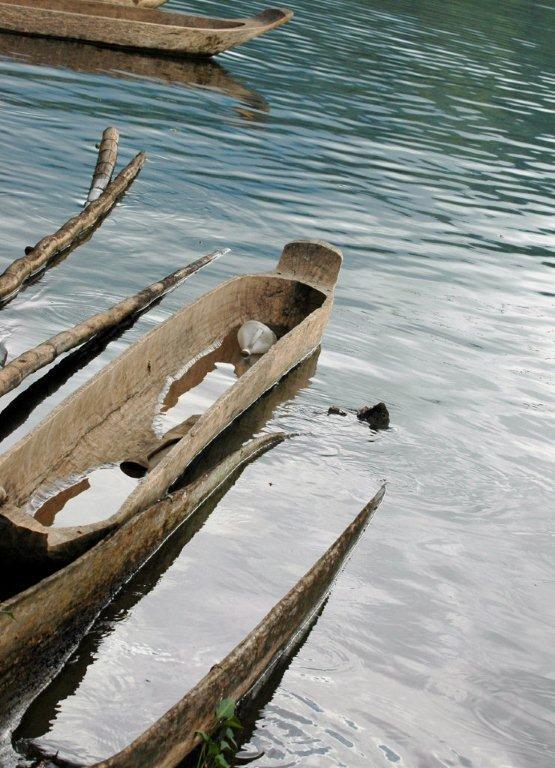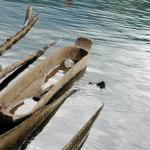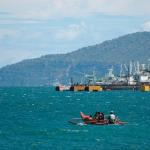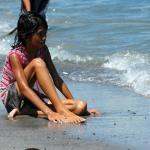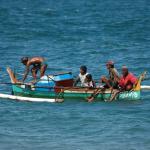The last Tribes of Mindanao, Badjao, the Sea Gypsies.
Badjao or Bajau means man of the seas, this tribal group is known as the Sea Gypsies because they move with the wind and the tide on their small houseboats called vintas, they can be found in many coastal settlements and inhabit the waters and shores of the Sulu archipelago.
A legend tells that these boat dwellers came from the shores of Johore in Indonesia, Princess Ayesha of Johore was betrothed to a Sulu Sultan but she really wanted to marry the Sultan from Brunei. One day, a large fleet of war boats escorted the Princess to Sulu, the fleet was intercepted by the man she really loved, the Sultan from Brunei, who kidnapped her and set sail back to Brunei. The escorting fleet could not return without the Princess and kept on sailing the seas, only mooring at uninhabited islands; some of them turned to piracy and roamed the seas to search for fortune and glory. Others only searched for food and became fishermen, the Sulu Sea had an abundance of fish that helped to sustain their livelihood, most of the daily catch was bartered with other tribes that lived along the shores and beaches. The Badjao still live in houseboats, clustered near the coastline of Southern Mindanao. But they also built stilt houses near fertile fishing grounds; these houses are a temporary refuge during times that these boathouses needed repairs. These wanderers of the Southern seas are born on the water, live on their boats and say they will only set foot on land only to die.
Although that their ancestors were once feared by many in the Mindanao region, the Badjao are primitive and friendly, they are believed to be world's most peace-loving people and consider themselves as a non-aggressive tribal community. Conflict with other tribes is often dealt with by fleeing to other places like the sea. Other tribes looked down on these fisher folk and did refer to them as palao or lumaan (God forsaken), the Badjao were influenced by Islam, but the continuous pressure put on by other Muslim tribes forced them to move to the sea, which gave them greater chances of escape in the case of an attack by hostile tribes. Eventually the sea molded the attitude and appearance of the Badjao, this rough environment and way of living shaped their typical physical features, the bronze coloured hair and dark brown skin clearly distinct them from other tribes.
The native religion from these water people is a form of ancestor worship, spirits, deceased ancestors and other relatives are asked for favours during frequent cemetery visits. They offer cigarettes and food and sweet smelling tonic is used for sprinkling the corners of the graves. These spirits are still part of the family; the seafarers of the Philippine South want these sprits to be as happy as the living and will therefore comfort them as much as they can. Some of the traditional pre-Islamic beliefs are offerings made to the God of the Sea, the Omboh Dilaut, whenever a large catch of fish is brought in and by setting a "spirit boat" adrift in the open sea, , mediums are also called upon to remove illness causing spirits from this boat-dwellers community in times of epidemics
By tradition, the hardworking and proud Badjao people are sea nomads, travelling by boat from one island to the other in search of fishing harvest. This pagan tribe have sailed the seas for more than a thousand years, but because of over fishing by other groups using everything from high-tech fishing trawlers and even dynamite fishing, threatened by soaring costs for fuel and repairs, their life in the open waters is drying up. These Bedouin of the sea no longer live on boats, they live in thatch-roofed houses on bamboo stilts on a small strip of land that nobody else wanted, somewhere along the coastline of Sarangani. With small, family owned bancas they continue to roam the waters, fighting the current to follow schools of fish, hunting for the bounty of the ocean, trying to make a living and find refuge in the vastness of the deep blue sea.
Despite the romantic portrayals of the tribe, the Badjao never really had an easy live, when they were still living at sea, they were at least free from the everyday rejection and hardship brought upon by other tribes that live on land. These guardians of the sea have experienced themselves that times are tough on the water, but worse on land. At present the Badjao are the most marginalized ethnic group and one of the poorest tribes in the Philippines, a Muslim tribe that is shunned by almost everyone, still gypsies, but also named tramps and thieves. Their vibrant nomadic lifestyle, the way of life bequeathed to them by their ancestors has vanished in most parts of Mindanao.
For centuries the Badjao have been a resilient tribal group, they firmly pushed away modernity with both hands, but tossed by modern winds they will have to find ways to maintain their unique lifestyle and culture, otherwise they will remain Godforsaken.
 ThingsAsian
ThingsAsian